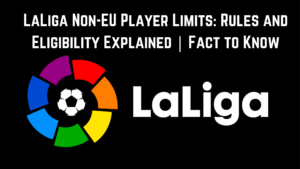Soccer Player Eligibility in LaLiga: Understanding Non-EU Nationals and Club Quotas

The summer transfer window is a pivotal period for LaLiga clubs as they work to strengthen their squads, address gaps, and finalize their rosters for the upcoming season. In Spain’s premier football division, teams often focus on acquiring national talent or tapping into the European market to secure emerging stars or crucial players to complete their lineups.
However, the search for talent extends beyond Europe, with clubs increasingly scouting players from South America, Africa, and the rapidly expanding Asian market. Players like Kang-in Lee and Take Kubo have demonstrated the growing influence of Asian talent in European football. Despite this global talent pool, LaLiga clubs face strict regulations on the number of foreign players they can sign, specifically those classified as “non-EU nationals.”
Who Qualifies as Non-EU Nationals in LaLiga?
According to LaLiga regulations, any player who does not hold European Union nationality is considered a non-EU citizen. However, there are ways for clubs to navigate these restrictions. For instance, FC Barcelona ensured that Lionel Messi, an Argentine, obtained dual nationality by acquiring Spanish citizenship, thus exempting him from being counted as a non-EU player.
In recent years, top LaLiga players such as Éder Militão, Vinicius Jr., and Ronald Araújo were initially counted as non-EU citizens for their respective teams. However, they have since acquired Spanish nationality, allowing their clubs to free up non-EU slots. The impact of Brexit has also influenced player eligibility, with England now considered a non-EU country. As a result, players like Jude Bellingham occupy non-EU positions at Real Madrid, a situation that did not apply to English players like David Beckham before Brexit.
Non-EU Player Limits for LaLiga Clubs
LaLiga enforces a strict quota on non-EU players, with each club allowed a maximum of three non-EU players in their squad. This rule was first introduced in the 1970s, coinciding with Johan Cruyff’s move to Barcelona, and the same limit of three non-EU players has been maintained since 1990.
The landmark Bosman ruling in 1995 revolutionized European football, ensuring that players born in EU member states would no longer be counted as non-EU nationals when playing for clubs in other EU countries. A relevant example is Atlético Madrid’s Rodrigo de Paul, an Argentine with Italian citizenship. Due to his EU nationality, he is not counted as a non-EU player, thereby not occupying one of the restricted slots on his team.
Understanding these regulations is crucial for LaLiga clubs as they navigate the complexities of building a competitive team while adhering to the non-EU player limits. This balance between acquiring global talent and complying with league rules is essential for success in Spain’s top football division.

2 Replies to “LaLiga Non-EU Player Limits: Rules and Eligibility Explained | Facts”